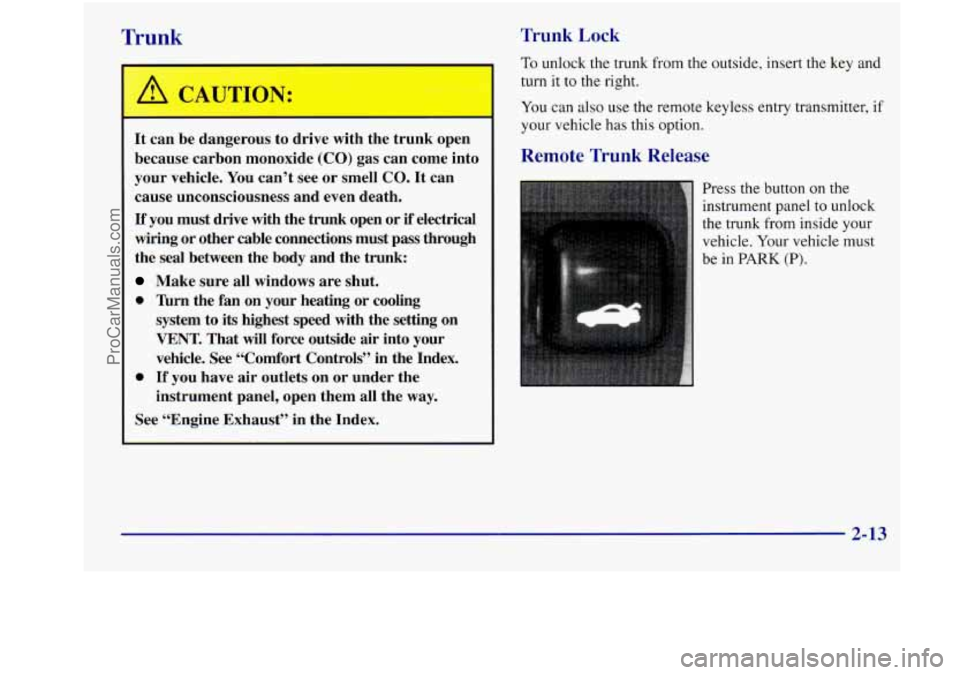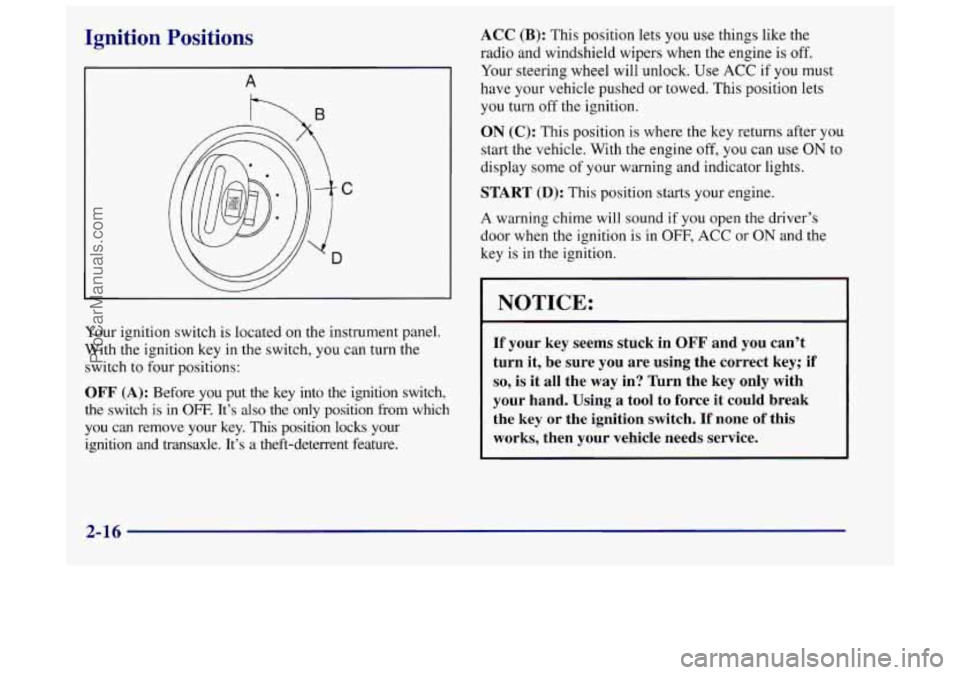instrument panel OLDSMOBILE INTRIGUE 1998 Owners Manual
[x] Cancel search | Manufacturer: OLDSMOBILE, Model Year: 1998, Model line: INTRIGUE, Model: OLDSMOBILE INTRIGUE 1998Pages: 340, PDF Size: 17.93 MB
Page 17 of 340

or the instrument panel ... or the safety belts!
With safety belts, you slow down as the vehicle
does.
You get more time to stop. You stop over more distance,
and your strongest bones take the forces. That’s why
safety belts make
such good sense.
1-9
ProCarManuals.com
Page 29 of 340

/I CAU’JON:
Children who are up against, or very close to, an
air bag when it inflates can be seriously injured
or killed. This is true even
if your vehicle has
reduced-force frontal air bags. Air bags plus
lap-shoulder belts offer the best protection for
adults, but not for young children and infants.
Neither the vehicle’s safety belt system nor its air
bag system
is designed for them. Young children
and infants need the protection that a child
restraint system can provide. Always secure
children properly in your vehicle. To read how,
see the part
of this manual called “Children” and
see the caution labels on the sunvisors and the
right front passenger’s safety belt.
There is an air bag
readiness light on the
instrument panel, which
shows an
air bag symbol.
I I
The system checks the air bag electrical system
for malfunctions. The light tells you if there is an
electrical problem. See
“Air Bag Readiness Light”
in the Index for more information.
1-21
ProCarManuals.com
Page 30 of 340

How the Air Bag System Works
1
Where are the air bags?
The driver’s air bag is in the middle of the
steering wheel. The right front passenger’s air
bag is in the instrument
panel
on the passenger’s side.
1-22
ProCarManuals.com
Page 31 of 340

If something is between an occupant and an air
bag, the bag might not inflate properly or it
might force the object into that person. The pat
of an inflating air bag must be kept clear. Don?
put anything between an occupant and an air
bag, and don’t attach or put anything on the
steering wheel hub or on or near any other air
bag covering. ;h t
When should
an air bag inflate?
An air bag is designed to inflate in a moderate to severe
frontal or near-frontal crash. The air bag will inflate
only if the impact speed is above the system’s designed
“threshold level.” If your vehicle goes straight into a
wall that doesn’t move or deform, the threshold level is
about
9 to 15 mph (14 to 24 km/h). The threshold level
can vary, however, with specific vehicle design,
so that it can
be somewhat above or below this range.
If your
vehicle strikes something that will move or deform,
such as a parked car, the threshold level will be higher.
The air bag is not designed to inflate in rollovers, side
impacts or rear impacts, because inflation would not
help the occupant.
In any particular crash, no one can say whether an air
bag should have inflated simply because
of the damage
to a vehicle or because of what the repair costs were.
Inflation is determined by the angle of the impact and
how quickly the vehicle slows down in frontal or
near-frontal impacts.
What makes an air bag inflate?
In an impact of sufficient severity, the air bag sensing
system detects that the vehicle
is in a crash. The sensing
system triggers a release of gas from the inflator, which
inflates the air bag. The inflator, air bag and related
hardware are all part of the air bag modules inside the
steering wheel and in the instrument panel in front of
the right front passenger.
ProCarManuals.com
Page 32 of 340

How does an air bag restrain?
In moderate to severe frontal or near-frontal collisions,
even belted occupants can contact the steering wheel
or the instrument panel. Air bags supplement the
protection provided by safety belts. Air bags distribute
the force of the impact more evenly over the occupant’s
upper body, stopping the occupant more gradually.
But air bags would not help you in many types of
collisions, including rollovers, rear impacts and side
impacts, primarily because an occupant’s motion is
not toward those air bags. Air bags should never be
regarded as anything more than a supplement to safety
belts, and then only in moderate to severe frontal or
near-frontal collisions.
What will you see after an air bag inflates?
After an air bag inflates, it quickly deflates, so
quickly that some people may not even realize the
air bag inflated. Some components of the air bag
module
-- the steering wheel hub for the driver’s
air bag, or the instrument panel for the right front
passenger’s bag
-- will be hot for a short time. The
parts of the bag that come into contact with you may be
warm, but not too hot to touch. There will be some
smoke and dust coming from vents in the deflated air
bags. Air bag inflation doesn’t prevent the driver from seeing or from being able to steer
the vehicle, nor does
it stop people from leaving the vehicle.
When an air bag inflates, there is dust in the air.
This dust could cause breathing problems for
people with a history
of asthma or other
breathing trouble.
To avoid this, everyone in the
vehicle should get out as soon
as it is safe to do so.
If you have breathing problems but can’t get out
of the vehicle after an air bag inflates, then get
fresh air by opening a window or door.
1-24
ProCarManuals.com
Page 33 of 340

In many crashes severe enough to inflate an air bag,
windshields are broken by vehicle deformation.
Additional windshield breakage may also occur from the
right front passenger air bag.
Air bags are designed to inflate only once. After they
inflate, you’ll need some new parts for your air bag
system. If you don’t get them, the air bag system
won’t be there to help protect you in another crash.
A new system will include air bag modules and
possibly other parts. The service manual for your
vehicle covers the need to replace other parts.
Your vehicle is equipped with a crash sensing
and diagnostic module, which records information
about the air bag system. The module records
information about the readiness of the system,
when the sensors are activated and driver’s safety
belt usage at deployment.
Let only qualified technicians work on your air
bag system. Improper service can mean that your
air bag system won’t work properly.
See your
retailer for service.
NOTICE:
If you damage the covering for the driver’s or the
right front passenger’s air bag, the bag may not
work properly. You may have to replace the air
bag module in the steering wheel or both the air
bag module and the instrument panel for the
right front passenger’s air bag.
Do not open or
break the air bag coverings.
ProCarManuals.com
Page 61 of 340

Section 2 Features and Controls
Here you can learn about the many standard and optional features on your vehicle, and information on starting,
shifting and braking. Also explained are the instrument panel and the warning systems that tell you if everything is
working properly
-- and what to do if you have a problem.
2-2
2-4
2-8
2-
13
2- 14
2- 14
2- 15
2-
16
2- 17
2-18
2-20
2-24
2-25
2-27 Keys
Door Locks
Keyless Entry System
Trunk
Theft
Passlock@
New Vehicle “Break-In”
Ignition Positions Starting Your Engine
Engine Coolant Heater (If Equipped)
Automatic Transaxle Operation
Parking Brake
Shifting Into PARK
(P)
Shifting Out of PARK (P) 2-27
2-28
2-28
2- 29
2-30
2-3
1
2-38
2-40
2-43
2-46
2-49
2-50 2-55 Parking Over Things That Burn
Engine Exhaust
Running Your Engine While You’re Parked
Windows Tilt Steering Wheel
Turn Signal/Multifunction Lever
Exterior Lamps
Interior
Lamps
Mirrors
Storage Compartments
Power Sunroof (If Equipped)
Instrument Panel
-- Your Information System
Warning Lights, Gages and Indicators
2-1
ProCarManuals.com
Page 73 of 340

Trunk Trunk Lock
It can be dangerous to drive with the trunk open
because carbon monoxide (CO) gas can come into
cause unconsciousness and even death.
If you must drive with the trunk open or if electrical
wiring or other cable connections must pass through
the seal between the body and the trunk:
Make sure all windows are shut.
0 lbrn the fan on your heating or cooling
1 your vehicle. You can’t see or smell CO. It can
system to
its highest speed with the setting on
VENT. That will force outside air into your
vehicle. See
“Comfort Controls” in the Index.
instrument panel, open them all the
way.
0 If you have air outlets on or under the
See “Engine Exhaust” in the Index.
To unlock the trunk from the outside, insert the key and
turn it to the right.
You can also use the remote keyless entry transmitter, if
your vehicle has
this option.
Remote Trunk Release
Press the button on the
instrument panel to unlock
the trunk
from inside your
vehicle. Your vehicle must
2-13
ProCarManuals.com
Page 76 of 340

Ignition Positions
A
hB
Your ignition switch is located on the instrument panel.
With the ignition key
in the switch, you can turn the
switch to four positions:
OFF (A): Before you put the key into the ignition switch,
the switch is in OFF. It’s also the only position from which
you can remove your
key. This position locks your
ignition and transaxle. It’s a theft-deterrent feature.
ACC (B): This position lets you use things like the
radio and windshield wipers when the engine is off.
Your steering wheel will unlock. Use
ACC if you must
have your vehicle pushed
or towed. This position lets
you turn off the ignition.
ON (C): This position is where the key returns after you
start the vehicle. With the engine
off, you can use ON to
display some of your warning and indicator lights.
START (D): This position starts your engine.
A warning chime will sound if you open the driver’s
door when the ignition is in OFF, ACC or ON and the
key is in the ignition.
NOTICE:
If your key seems stuck in OFF and you can’t
turn it, be sure you are using the correct key; if
so, is it all the way in? Turn the key only with
your hand. Using
a tool to force it could break
the key
or the ignition switch. If none of this
works, then your vehicle needs service.
2-16
ProCarManuals.com
Page 91 of 340

Turn SignaVMultifunction Lever
The lever on the left side of the steering column
includes your:
Turn Signal and Lane Change Indicator
Headlamp High/Low Beam Changer
Headlamps
Taillamps
0 Parking Lamps
nrn Signal and Lane Change Indicator
The turn signal lever has two upward (for right) and two
downward (for left) positions. These positions allow you
to signal a turn or lane change.
To signal a turn, move the lever
all the way up or
down. When the turn is finished, the lever will
return automatically.
11 An arrow on the instrument
1
A panel will flash in the
direction of the
turn or
lane change.
2-31
ProCarManuals.com